Making breaded gluten free calamari at home is inexpensive and easy with frozen squid tubes. If you're trying to eat less highly processed foods lean into all the ways gluten free cooks make breading and batter. Those are ideas you can use on fish, chicken and veggies to make all the crunchy, breaded foods you love.
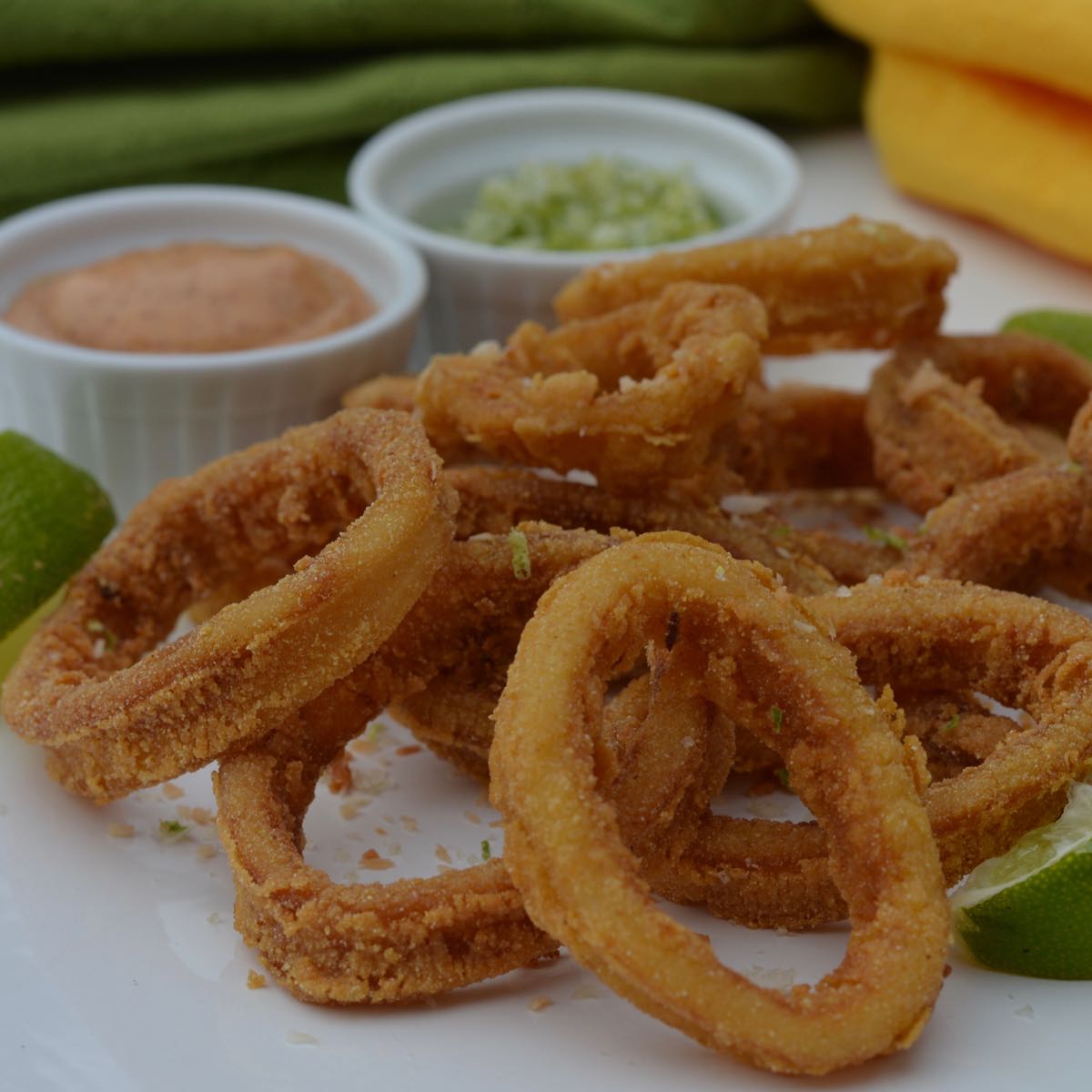
This recipe uses corn flour and masa harina. I most often use corn flour to make cornbread, muffins and homemade pasta. I see it can also be an ingredient in gluten free flour blends. Masa harina, a specially treated version of corn flour, is used to make tamales, corn tortillas and I also use it to thicken my Ancho Chile Gravy.
There are lots of possibilities! To learn more about all the corn options for gluten free cooks, check out my post How To Use Corn Flour, Cornmeal and Masa Harina.
Jump to:
🌽 Ingredients
If you haven't cooked squid before it's definitely worth trying. Look for it in the freezer section where you find fish and seafood. Getting some into your freezer is the first step.
- frozen squid tubes
- milk
- corn flour
- masa harina
- oil for deep-frying
- shredded coconut
- sea salt
- limes
- mayonnaise
- ancho chile powder
See recipe card for exact amounts.
🌽 Instructions for Cooking Squid
There are two ways to cook squid; quickly on high heat or low and slow. Deep-frying is a quick method. Pre-soaking the rings in milk before cooking is one way to get tender calamari so don't skip that step.
🌽 Substitutions
Do not substitute a gluten free flour blend for either the corn flour or the masa, especially a flour blend that contains a binder (xanthan gum or guar gum). For cooking breading recipes work best with a starch or some individual flours like you see here.
Corn flour - If you don't have corn flour you can substitute cornstarch, tapioca starch or sweet rice flour. These are the three I typically use for cooking. As you learn more about different flours you can try them and see if you like how they work.
Masa Harina - Try using corn flour to keep a corn flavour in this calamari recipe but there is no real substitute for this unique ingredient.
🌽 Variations
Squid are found worldwide and fried squid is popular in many coastal cultures around the world. Calamari is the Italian word for squid. It does refer to a specific type of squid that is said to be the most tender species of squid. Where I live it's all just labelled squid.
Mexican or Latin American - I made this corn breading for my Gourmet Dinner Club night with a Mexican theme.
Greek - For a Greek menu replace the mayo, lime and coconut and serve it with with tadziki.
Italian - I've had many Italian dishes with unbreaded squid in tomato sauce. For a breaded version to go with an Italian menu simply serve a nice tomato sauce on the side for dipping.
🌽 Equipment: Wok vs Deep-Fryer vs Air Fryer
Many gluten free cooks buy a deep fryer after learning that gluten crumbs are in the oil in restaurant fryers. Only foods prepared in a dedicated gluten free fryer are safe for celiacs.
I've been deep frying in my flat bottom wok for years and it doubles as my deep-fryer. The small base with a larger surface area at the top is ideal for deep frying. It comes with a long-handled wire strainer and I have a deep frying thermometer. If you're considering buying a wok I use mine for all these purposes.
- Steaming salmon or boiling bagels.
- Stir fry dishes like veggie stir-fry, beef and bok choy or any noodle stir fry.
- As a large frying pan when I'm entertaining and making a large recipe like Madeira Chicken with Asparagus.
Some of you are loving your air fryers but I haven't bought one so I can't comment.
🌽 Top Tip: Organize For Success
My best tip for deep frying at home is put in the effort up front. Create a system so when you think of a recipe you want to make, you don't dread the process. Store things in convenient places and make it work for you.
You can find more about my set up and clean up for deep frying in these recipes.

Gluten Free Calamari with Ancho Chile Mayo
Ingredients
CALAMARI
- 4 frozen squid tubes, thawed, sliced into ½” rings
- ½ cup milk
- ½ cup corn flour
- ½ cup masa harina
- oil for deep-frying
COCONUT
- ¼ cup shredded coconut
LIME SALT
- 2 tablespoon sea salt
- 1 lime zest only
ANCHO CHILE MAYO
- ½ cup mayonnaise
- 1 tablespoon lime juice
- ½ teaspoon ancho chile powder
- salt to taste
- GARNISH – lime wedges
Instructions
CALAMARI
- Place squid rings in a shallow bowl and pour milk on top. Cover and refrigerate for 3 hours.
- In another shallow bowl combine flours and set aside.
COCONUT
- Toast coconut in 350°F oven for 5 minutes. Set aside.
LIME SALT
- In a small serving dish combine salt and lime. Set aside.
ANCHO CHILE MAYO
- Combine all ingredients in a bowl. Transfer to small dish for dipping. Set aside.
FRYING
- Heat oil in deep-fryer or wok to 350°F. Line a plate with paper towel.
- Remove the squid from the milk and place it in the bowl with the flours. Toss until evenly coated. Shake off excess flour.
- Carefully slide squid into the oil in small batches so it is submerged. Cook for 3-4 minutes until golden. Gently transfer to a plate.
- Allow oil to come back up to 350°F before cooking the next batch. Repeat until all the calamari is cooked. Transfer to a serving platter and garnish.
FINISHING
- Sprinkle with lime salt and coconut. Serve Ancho Chile Mayo and additional Lime Salt on the side.
__________________________________________________________________________
New here? I've got help to get you from overwhelmed and frustrated to confidently cooking gluten free food the whole family wants to eat. Subscribe and get your free resource, 29 Tips for GF flour.
🎉 I made it into the Top 100 Gluten Free Blogs for 2025 and the Top 40 Gourmet Food Blogs. To learn all the ways I can help you click here, Everyday Gluten Free Gourmet.
_________________________________________________________________________



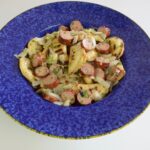

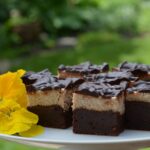
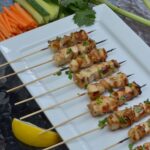
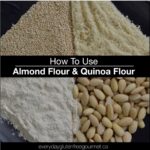
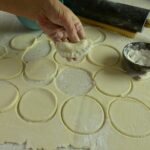
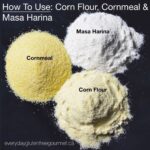

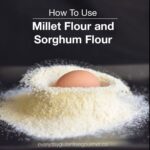


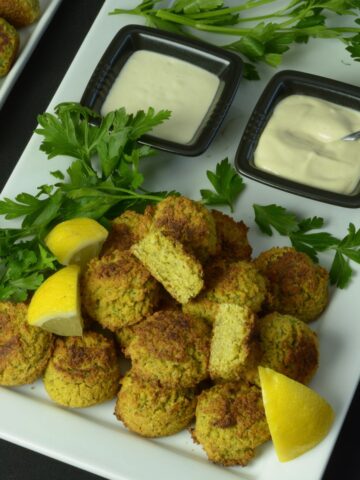
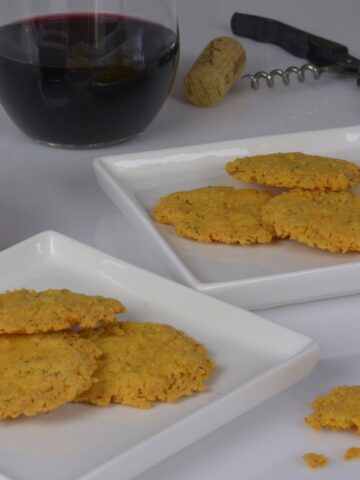
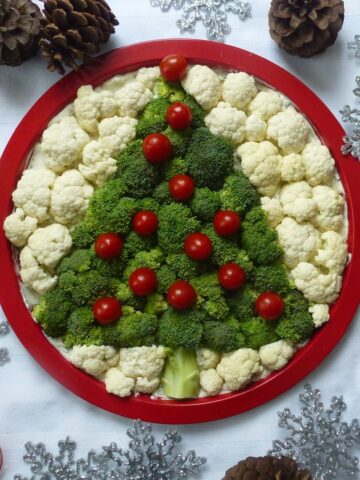

Leave a Reply